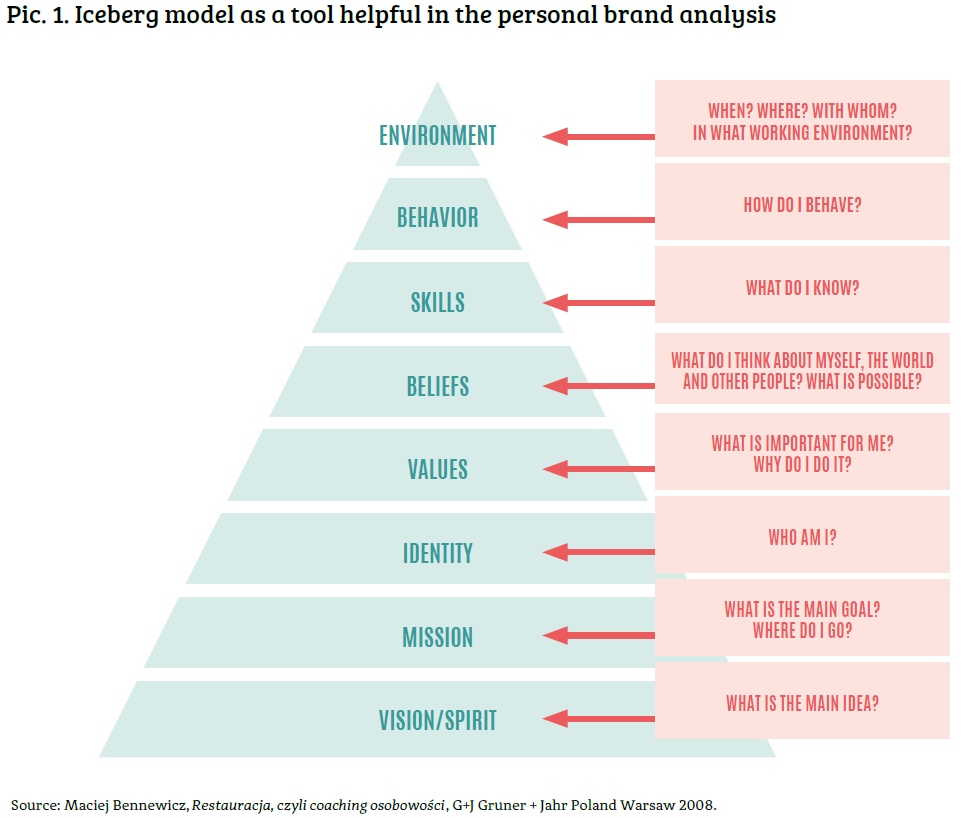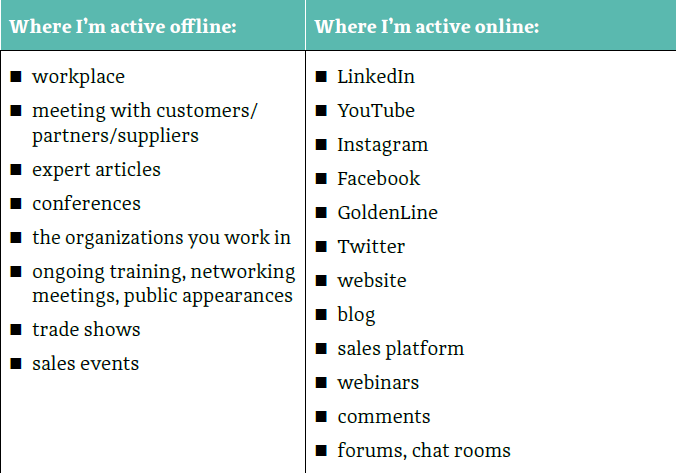Personal branding, or how to build your personal brand in sales
In the sales world, where the number of interpersonal contacts with clients, suppliers, partners and associates is above average, it’s worth finding time to analyse what brand we’ve managed to create so far and what positive or negative consequences it creates.
Dostępny jest przetłumaczony materiał kliknij tutaj, aby przejść do materiału.

What is a personal brand?
It’s your image, the accumulated reputation capital on the basis of which people around you either decide to enter into professional and private relationships with you, or to avoid such relationships because of their negative evaluation of your brand. Joanna Malinowska-Parzydło, author of the book You’re a brand. How to be successful and remain yourself, draws attention to the fact that our brand is our strategic capital, which, especially in professional areas, will decide our success or failure. The contemporary world is so diverse and saturated with information that the majority of consumers are guided in their choices by signposts - brands, which make it easier to choose from thousands of possible opportunities. Would you like to stand out in the market? Analyse what market image you’ve built so far and think about whether or not to modify the adopted strategy 1.
Where to start?
The first step we should take is to look at our existing image on the sales market, on the basis of which our brand is perceived by clients, partners, and competitors. Our key areas of exploration will answer the following questions:
- What kind of salesperson am I? What talents do I have, how do I stand out? And what limits me, what can’t I do?
- How do clients perceive me? What do the competition think of me, if anything? Where should I sell my brand?
- What image I have created in social media, and how I am seen every day? Am I consistent?
- What intellectual/material/personal resources do I use? How does that support/weaken my professional brand?
- What was the purpose of the action taken? What does value mean to me? On what do I base the trust and professionalism of my brand? What is my goal?
Personal branding has been a very popular phrase in recent years. It appears as the subject of many articles, training programmes, and goals implemented as part of mentoring and coaching processes. We want to learn how to build our personal brand in order to effectively fulfil our chosen role, often without realizing that each of us already has a personal brand that is the result of our previous behavior, attitudes, and experiences.
Time devoted to a thorough analysis of the topic, and honest answers to the questions will help us transition to the next stage, which will be creating a premium sales brand, that is, a brand that will stand out on the market and reach our desired customer group.
Key terms to build a credible sales brand
Nowadays, it is necessary to be present in social media to build a recognizable and professional brand. Since you’ve already analysed the actions and image you’ve created thus far, consider whether your online and offline professional personas are consistent. This is the basis for building the credibility of your message.
Are your profile and activity in social media consistent with the image you build on a daily basis in direct interpersonal communication? If the goal of your activities - including public appearances, conducting meetings with partners or writing articles for industry media - is to build the brand of a professional salesperson, then have a look at what you communicate via social media. Unconscious comments, uncensored pictures, or inappropriate vocabulary on social media may negate the effort you’ve put into building a professional sales brand. In a world where the product or service selection/evaluation stage - which customers complete independently, online - is no longer part of the purchase process, remember that they can also verify your professional credibility and competence online. So, when deciding on any online activity, think about how it can strengthen or weaken your brand.
Step by step
If you decide to build a new personal brand (which won’t be easy if your current brand is perceived negatively) or redefine an existing one, you can use the following plan of action based on the CANVAS business model 2:
STEP 1:
Define your goal
What do you want to achieve as a salesperson? What do you care about most - building a wide network of commercial contacts, achieving certain revenues, or maybe promoting a new quality of customer service? Specify the values you want to offer to customers, suppliers, partners or colleagues. Your answers will direct you to the best path to achieve a specific goal and help you define the next steps.
STEP 2:
Specify your target group
To whom do you want to target your products or services? Where will you find the demand that will allow you to meet the goal you set in the first step?
STEP 3:
Set up communication channels
How will you communicate with selected client groups? What relationship will you establish with them? Choosing specific client groups will allow you to make decisions about the communication channels you’ll use. Different groups will require different channels; for example, customers from generation Z do everything online, while your LinkedIn profile won’t determine the strength of your image with senior citizens, who value personal relationships. When building a coherent and credible brand, you need to know who you want to sell it to.
STEP 4:
Specify actions leading to your goal
Think - what key actions do you need to take to achieve your goal for selected client groups? Specify the material, intellectual, or personal resources necessary for that. For example, if the purpose of building a strong personal brand is to achieve high earnings by providing your services to a defined group of affluent clients, then you need to know what actions are necessary to reach that group and build and maintain relationships. Most likely, apart from a well-planned online image-building strategy, you’ll have to take offline actions that will allow you to reach the selected group directly and present yourself as a prestigious brand. It may also be necessary to invest in material resources, such as professional clothing or high-end gadgets which support your image integrity.
STEP 5:
Build a network of partners
Take advantage of the opportunity to build a network of key partners (for example, in the case of a financial adviser - real estate agents, experts, translators, notaries, law firms, surveyors, etc.) who will strengthen and promote your brand. Make sure that they are consistent with your image strategy.
STEP 6:
Prepare a simplified revenue and cost statement for the selected business model
Analyse what material, time, and personal costs, etc. you’ll incur in connection with the implemented strategy, and what profits it will bring in relation to the chosen goal. Skipping this step may result in poor decisions regarding building a personal brand if, for example, it turns out that acquiring a selected group of clients is so expensive that you won’t be able to achieve the profit goal you have set. As a result, you may deem your goal of building a personal brand as a salesperson for wealthy clients as unattainable, which will result in discouragement and frustration.
A personal brand with a sense of meaning
Maciej Bennewicz’s Iceberg exercise is an excellent tool for reviewing your personal brand, as it allows you to look at your role both on ostensible and deep, often unconscious levels. Building a coherent and credible personal brand requires laying solid foundations or looking at deeply hidden motives that determine our behavior and attitudes. Using Bennewicz’ method, we analyse the salesperson’s role by answering the auxiliary questions assigned to each level.
The starting point is our work environment and our behavior which is visible to external observers. At these levels, we answer the following questions:
ENVIRONMENT: where do I work? with whom? what tools do I use? what is the image of my company?
BEHAVIOR: how do I behave? what do I do? how do I get/serve clients? how do I look? what do I say?
The answers obtained relate to the metaphoric “tip of the iceberg” that protrudes above the surface of the water. It is visible to our clients, partners and colleagues, so when building our image on social media, we must remember to maintain coherent online and real-world images. However, the true strength of the iceberg is below the surface, which hides the invisible mass that determines its potential. So, if you want to build a strong and stable brand, look at the deeper levels of your role:
SKILLS: what am I able to do? what sales/communication/negotiation skills do I have?
BELIEFS: what do I think about my role as a salesperson? what’s possible and what’s not in this role/in my company? what do I think about my clients/suppliers/partners, etc.?
This level often reveals our limiting beliefs, which block our professional development and thus make it difficult to develop the full potential of our brand. For example, if your professional experience has confirmed that you shouldn’t trust clients because they often use your time and expertise to collect product information, only to buy from the competition, it will translate into your behavior manifesting itself as distrustful. In such a situation, it will be difficult to build the brand of a salesperson open to clients, as that image will be inconsistent with your behavior.
VALUES: on what values is my role based? what’s important to me - perhaps communication with clients, high quality service, or maybe earning money and spending it on my own interests?
IDENTITY: who am I?
MISSION: what’s the bigger goal? what’s most important? why am I doing this?
VISION/SPIRIT: what’s there more of?
The last three levels represent our deepest layers, which we often aren’t conscious of, and which often lie “dormant” for many years. It is worth analysing them and looking for answers, even if it seems difficult at the beginning, and even if such analyses only result in “I don’t know”. The reward for this effort will be to find meaning and understand the reasons for the choices we’ve made while deciding to fulfil certain roles. Effective personal branding, especially in the professional area, must be based on a conscious and careful reflection on the role played so that our brand is coherent and convincing. Without meeting these criteria, we won’t create a reliable sales brand, we’ll create a virtual character that will sell only until the emand for other products, services or trends appears on the market.
Przypisy / Źródła
- Joanna Malinowska-Parzydło, Jesteś marką. Jak odnieść sukces i pozostać sobą, Helion, Gliwice 2015.
- Alexander Osterwalder , Yves Pigneur, Tworzenie modeli biznesowych. Podręcznik wizjonera, Helion, Gliwice 2013.
















